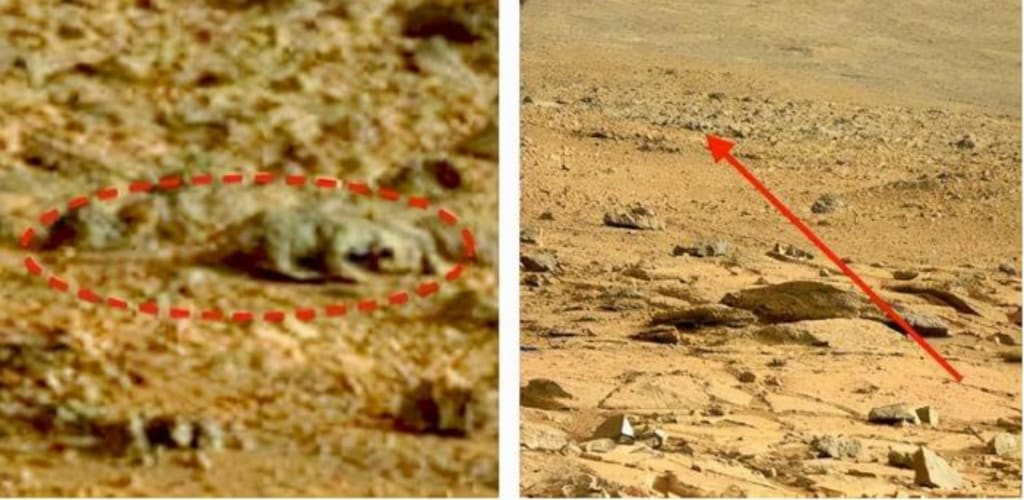
It is well known that the United States is the country that has explored Mars the most times in the world because it also has more information about Mars than any other country. Many of the real pictures of Mars that we usually see in the news media are almost always taken by U.S. orbiting rovers and Mars rovers. The images we have seen are only a small part of the picture, NASA has kept a considerable number of images unpublished, which can be seen in their newly released photos last August.
Last August marked the 15th anniversary of the official start of NASA's Mars Exploration Orbiter (MRO for short). MR has been in space service since 2005, and it was originally scheduled for a five-year service period, but NASA extended it to 2020 due to good operational conditions in the later years. To celebrate this big event, NASA released to the public MRO captured several photos, these photos are never seen before.
One of the photos caught the attention of netizens, in which a lizard-like object appeared on the barren ground of Mars. The part was circled and put on the Internet, and immediately attracted the attention of netizens from all over the world. The discussion about life on Mars has been raised again, so is the object in the photo a lizard? Besides, does life exist on the surface of Mars?
What is the story of the "lizards" on the surface of Mars?
This photo with "lizard" was taken by Mars rover "Opportunity" in the early days. A Japanese netizen made detailed observation of the photo after NASA released it and finally found a lizard-like object in a pile of messy rocks. From the appearance, the object does look like a lizard, with a long tail as well as a flattened body, and four feet in a crawling position on the ground.
Japanese netizens who found this mysterious object had a brainstorm that it was a Martian lizard, but other netizens expressed a different view. Most of them believe that according to the special objects NASA has found on the surface of Mars in the past, the object is likely to be a relatively unique shape rock. Even if the "Martian lizard" is not a rock, it is unlikely to be Martian life, because the natural environment on the surface of Mars has three fatal problems: no water, no oxygen, and high radiation.
There are also more interesting views on the Internet that the "lizard" is a real lizard, which originally came from Earth and was later brought to Mars by the Mars rover for survival experiments. NASA has not publicly given any response to the different suspicious voices on the Internet. But according to the European Space Agency experts, this "lizard" is not a real lizard, it is just a unique shape of the stone. In addition to the Martian "lizard", many Mars rovers have taken several controversial pictures, here to learn more.
What other controversial photos have been found by Mars rovers throughout history?
In the early history of U.S. Mars exploration, one of the most representative controversial pictures may belong to the 1976 "Pirate I" from above down to the surface of Mars a suspected "human face" picture. I believe that many people have seen this picture, it gives people the first impression is really like a mask, rather than a real human face. Even so, there are still many people who believe that its appearance indicates that there may be an alien civilization on Mars similar to the human civilization that created such a large symbol.
Since humans did not know much about Mars at that time and did not yet realize that life was unlikely to exist on the surface of Mars, it was speculated that the image was evidence of the existence of a Martian civilization. Twenty years later, NASA sent another probe to Mars and found that the faces on the surface were merely shadows formed by the sunlight on the mountains. Another controversial image, taken in 2007, was taken by another Mars rover, Courage.
The background of the photo is a mountain slope in the daytime on Mars, which also looks like a desert from a distance, but some careful astronomy enthusiasts found a suspicious image of a human silhouette on the slope, which looks like sitting on a rock to rest. As the silhouette was more obvious under the sunlight, it attracted great attention at that time, and many authoritative media in the United States reported this matter, many of which interpreted the image as a strange rock on Mars.
But there are still people who hope it is evidence of the existence of alien life on Mars and list the mysterious photos found on Mars in the past, trying to dominate the direction of public opinion. But eventually, NASA came forward to respond to the matter, saying that the objects suspected to be human figures in the pictures were probably just rocks, which only made many pie-in-the-sky speculations fall into place. In addition to the above two events, there are not many cases of mysterious pictures taken on Mars, but most of them were eventually explained as Martian rocks.
Is it possible for life to appear on the surface of Mars?
Even so, there are still a few astronomy enthusiasts who insist that life exists on the surface of Mars, only that humans have not yet discovered it, so let's analyze the question: is it possible that life exists on the surface of Mars? First of all, let's talk about the basic conditions and natural environment of Mars, its diameter is about 6786 km, the volume is only 15% of the Earth, the mass is only 10.8% of the Earth, and there are four seasonal changes a year, and there are two satellites, it sounds similar to the conditions of the Earth.
Mars also has a thin atmosphere. 95% of the atmosphere inside is carbon dioxide, 2.7% is nitrogen, and oxygen and water vapor only account for about 0.13% and 0.03% of the total, respectively. Because the atmosphere is full of carbon dioxide, scientists also believe that there is a greenhouse effect on Mars. Even so, the maximum daytime temperature on Mars does not exceed 22 degrees Celsius, while the nighttime temperature can be as low as minus 70 degrees Celsius, and the temperature difference between day and night can exceed 100 degrees Celsius.
Then look at the rocks and soil of Mars, the main components of both are quartz and hematite, of which hematite is the reason for the orange-red appearance of the surface of Mars. Apart from these two major components, there are very few other components in the soil, let alone organic ones. There is another key factor that cannot be ignored, and that is that the atmosphere of Mars is too thin, resulting in the intensity of solar ultraviolet and cosmic radiation on its surface reaching biologically lethal doses.
Then let's look at what kind of conditions life needs to survive. The first is liquid water, the surface of Mars in addition to the existence of ice caps in the north and south poles, other regions have not yet appeared in liquid water. Next is the right temperature, Mars day and night temperature difference of more than 100 degrees Celsius, which almost no Earth life can withstand. Then there is the protection of the atmosphere, which includes the provision of sufficient oxygen and weaken solar radiation and cosmic radiation.
Thus, it seems that none of the three basic conditions for the existence of life on the surface of Mars are met, so it can be tentatively determined that life is unlikely to exist on the surface of Mars. Most of NASA's scientists had no hope for the surface of Mars before the launch of Curiosity 21, so they hope that the future development of Mars rover can go deep into the subsurface of Mars to explore, although the surface of Mars does not exist life, there may be hope for the subsurface of Mars.
Since life is unlikely to exist on the surface of Mars, what about the subsurface space?
Curiosity is the first nuclear-powered rover in human history, which allows it to operate more stably on Mars and also gives it enough power to drill into the Martian subsurface. Curiosity landed on Mars after years of exploration activities in Gale Crater, and it is now certain that it found mineral salt-rich sediments in Gale Crater, which indicate the possibility of the existence of brine lakes in the area, and therefore its subsurface space has great drilling value.
Before Curiosity was even retired, NASA launched the Trailblazer probe last summer. So far, Trail has entered Mars' orbit and sent back several photos of the surface to the surface. The photos show four or five hill-like structures in a relatively smooth area of Mars, with a hole in the center of the hill. Some scientists speculate that these hills were once volcanoes on Mars, so is there life hiding in the crater?
In addition, last year, scientists from the Mars orbiter pictures also found the surface of Mars appeared long raised structures, after analysis that is most likely to be Mars's underground molten lava pipeline. Such underground structures also exist on Earth, and they are the conduits for the flow of volcanic lava. When the volcanoes go dormant, the lava in the conduits disappears, but the conduit structures remain stable. From the external structure, the diameter of the lava pipes on Mars is about 5 times larger than the diameter of the pipes on Earth.
Therefore, some scientists have proposed a vision, of whether future human beings can use these underground molten slurry pipes as a construction base. In such an underground structure, humans are greatly reduced by space radiation and day and night temperature differences, and more closed space is conducive to the creation of an oxygen environment for humans.
What are the ways to terraform the Martian environment? So far, the scientific community has proposed three ways to achieve the "terraforming of the Martian environment". The first method is to build a huge reflector to reflect the sunlight, so that the sunlight shines on the surface of Mars, thus increasing the average temperature of the surface. There are American scientists have calculated the size of the reflector to achieve the purpose, the diameter of at least 250 kilometers, the area is a little larger than the U.S. Lake Michigan.
The second method is to create more greenhouse gases on Mars to fill up the Martian atmosphere, thus keeping more solar radiation on Mars and eventually achieving the goal of raising the Martian temperature. This doesn't seem too difficult for humans to do; after all, we've been doing this for the last hundred years or so. A third method would be to direct an asteroid to hit Mars and use the heat from the impact to raise the temperature of Mars. Which of these methods do you think would work? Or do you have other ideas?
About the Creator
Sukkning
Science will give mankind's greatest gift is? Is to make the power of humans believe that truth。






Comments
There are no comments for this story
Be the first to respond and start the conversation.